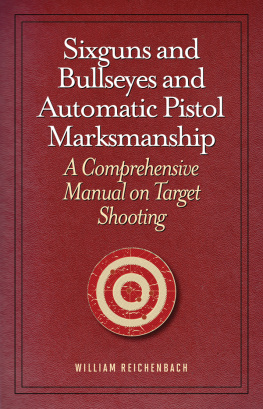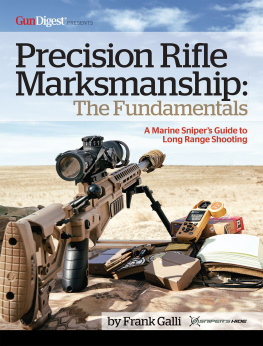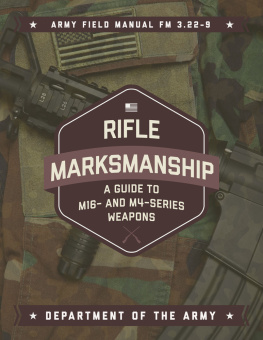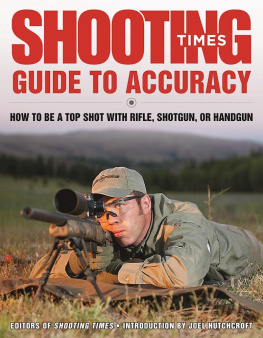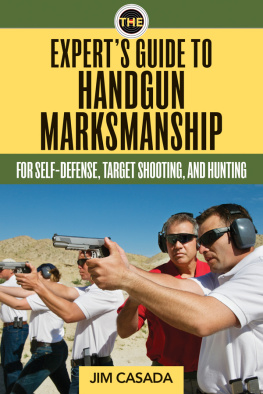Handgun Marksmanship:
Teach Yourself to Shoot Bullseyes
By Harvey Berman
Copyright 2017 Harvey Berman
Edition 1.04
All Rights Reserved
Table of Contents
Preface
According to the Merriam-Webster Dictionary, a marksman is someone skilled at shooting at a mark or target.
Who This Book Is For
This is a book for hand-gunners who want to be marksmen.
About This Book
Handgun Marksmanship is a learners guide to shooting straight and hitting what you aim at. Each chapter is a separate lesson designed to achieve clear instructional goals.
The book has six parts:
- Preparation for training. Things you should know before you fire the first shot in training.
- Target analysis. How to choose and use a target for marksmanship training.
- Goal setting. How to set a good training goal, based on gun, ammo, and shooter skill.
- Fundamentals of marksmanship. How to maintain sight alignment through the trigger press.
- Dry fire practice. How to refine skills in the comfort of your home.
- Getting better. How to achieve new levels of marksmanship proficiency.
Topics are explained in clear, aw-shucks language. Step-by-step instruction makes it easy to grasp material quickly. Key points are reinforced with practical exercises.
What You Will Learn
As you progress through the book, you will learn to:
- Test the mechanical accuracy of your gun and ammunition.
- Properly align sights to hit your intended target.
- Identify the shooting grip and stance that work best for you.
- Translate dry-fire practice to improved performance on the range.
- Set clear, measureable goals for marksmanship training.
- Assess shooting accuracy and precision objectively.
- Diagnose flaws in technique, based on bullet-hole patterns.
- Test corrective strategies to solve performance problems.
Each lesson is geared toward skill development and continuous improvement. By the end of the book, you should be able to:
- Hit 80% bullseyes (4 shots out of 5) from a distance of 7 yards, assuming the bullseye is a circle with a 1-inch radius.
If you think this is easy, try it. This is a significant achievement with a handgun, beyond the skills of most shooters. But, with a little bit of the right training, it is well within your grasp.
Why This Book?
There is nothing hard about developing handgun marksmanship skills. But there are a few moving parts. This book focuses on the most important parts, so you can quickly acquire the skills you need to hit the bullseye (almost) every time.
Part 1. Preparation forTraining
This book is a self-instructional guide for handgun marksmanship. By following the step-by-step training program described in the book, you can teach yourself to hit what you aim at.
However, before you fire the first shot in training, you need to understand two things:
- Marksmanship takes effort. To shoot well, you need to learn the fundamentals, and you need to practice. The book will guide you every step of the way, but you do have to make the effort. describes what you should expect to put into training and what you can expect to get out of training.
- Handgun safety is paramount. Since this is a marksmanship training program, you will be shooting a firearm. This means you have to practice accepted gun safety rules. Always! To keep yourself and everyone around you safe, we review gun safety in .
With this preparation behind you, you will have a solid foundation to develop strong shooting skills quickly.
Lesson 1. About This Training Program
The marksmanship training program described in this book has been carefully developed, using best practices in instructional design. It really works, but it only works if you put in the effort if you use the training aids and work through the exercises.
Im guessing that you will put in the effort if you judge that the costs (time and energy) yield an appropriate benefit (consistent bullseyes at the range).
What Will I Learn?
At the end of this lesson, you will be able to describe:
- How this training program was designed.
- What you should expect to put into the program.
- What you can expect to get out of the program.
This lesson will help you make an informed choice about whether the training program described in this book is right for you.
What Do I Need?
To complete this lesson, you will need the following:
Basic Marksmanship Training
Whether you learn about marksmanship from a book and/or from an instructor, every marksmanship training program focuses on:
- Learning the fundamentals of marksmanship (sighting, grip, stance, etc.).
- Practicing the fundamentals, through dry fire practice (without bullets) and/or live fire practice (with bullets).
This approach is tried and true. It is, no doubt, the way Annie Oakley learned to shoot. If you can execute the fundamentals, you will hit what you aim at.

Annie Oakley
So if the traditional approach can work, why would we want to change it? In the words of Bert Lance, If it aint broke, dont fix it.
Heres the issue. Although the traditional approach can work, it doesnt always work. Without a good instructor, the traditional approach often falls short. Progress is slow, and skills are weak. This leads us to ask: What distinguishes effective marksmanship training from ineffective marksmanship training?
Lessons from Science
Scientists have studied instructional design, and they have identified attributes of training that are correlated with efficient skills acquisition. These attributes include:
- Goals and objectives. Training programs are more effective when (a) they have clear, measureable objectives and (b) the objectives are communicated to students. The main training objective should be challenging, yet achievable.
- Knowledge of results. There is no learning without knowledge of results. Students should receive prompt, objective feedback regarding their performance of skills.
- Performance analysis. Effective training should (a) identify gaps between training objectives and actual performance, and (b) suggest remedies to close those gaps.
- Transfer of training. Knowledge gained in training is applied more effectively in the real world when conditions in training are similar to conditions in the real world.
When these attributes are built into a training program, learning is facilitated; when they are missing, learning is impeded.
How is This Scientific?
Like every other book on marksmanship, this book emphasizes learning and practicing fundamental skills (sighting, grip, stance, etc.). But unlike most other books on marksmanship, this book explicitly incorporates lessons from science.
There is a rigorous focus on training program goals and objectives. Each lesson begins with a clear statement of what you will learn from that lesson. The overall training program objective, developed in , is clear, challenging, and attainable. Practice drills emphasize feedback and performance analysis. They require you to pay attention to what you are doing and observe how you can improve. To promote transfer of training, dry fire practice mirrors real-world conditions as closely as possible.
Next page







